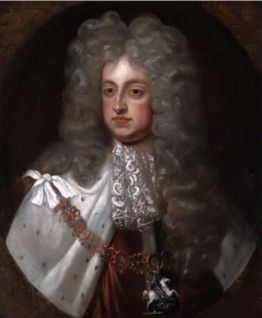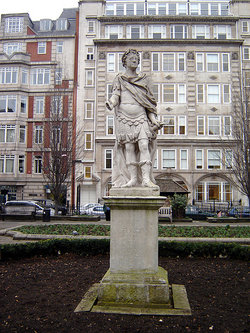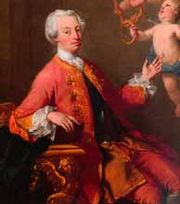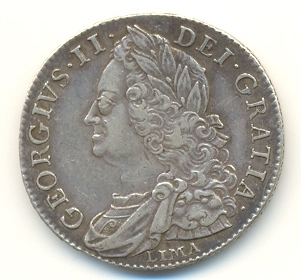George II of Great Britain
2007 Schools Wikipedia Selection. Related subjects: Monarchs of Great Britain
| George II | |
|---|---|
| King of Great Britain and Ireland Elector of Hanover; Duke of Brunswick-Lüneburg |
|
 |
|
| Reign | 11 June 1727 – 25 October 1760 |
| Coronation | 4 October 1727 |
| Predecessor | George I |
| Successor | George III |
| Consort | Caroline of Ansbach |
| Issue | |
| Frederick, Prince of Wales Anne, Princess Royal Princess Amelia Sophia Princess Caroline Elizabeth Prince George William of Wales Prince William Augustus, Duke of Cumberland Princess Mary, Landgravine of Hesse Louise, Queen of Denmark and Norway |
|
| Full name | |
| George Augustus German: Georg August |
|
| Titles | |
| HM The King HRH The Prince of Wales HRH The Duke of Cornwall HSH The Duke of Cambridge HSH The Hereditary Prince of Hanover HSH Prince Georg August of Hanover HSH Duke Georg August of Brunswick-Lüneburg |
|
| Royal House | House of Hanover |
| Royal anthem | God Save the King |
| Father | George I |
| Mother | Sophia of Celle |
| Born | 10 November 1683 Herrenhausen Palace, Hanover |
| Died | 25 October 1760 Kensington Palace, London |
| Burial | 11 November 1760 Westminster Abbey, London |
George II (George Augustus; 10 November 1683 – 25 October 1760) was King of Great Britain and Ireland, Duke of Brunswick-Lüneburg (Hanover) and Archtreasurer and Prince-Elector of the Holy Roman Empire from 11 June 1727 until his death.
He was the last British monarch to have been born outside of Great Britain, and was famous for his numerous conflicts with his father and, subsequently, with his son. As King, he exercised little control over policy in his early reign, the government instead being controlled by Great Britain's first (unofficial) " Prime Minister", Sir Robert Walpole.
Early life
HSH Duke Georg August of Hanover was born at Herrenhausen Palace, Hanover. He was the son of Georg Ludwig, then the Hereditary Prince of Brunswick-Lüneburg, and his wife, Sophia of Celle; the latter's alleged adultery led to them being divorced in 1694.
He married Margravine Caroline of Brandenburg-Ansbach in 1705.
Act of Settlement
Under the Act, the Hereditary Prince became a naturalised English subject in that same year. Anne, who had succeeded to the English Throne in 1702, admitted him to the Order of the Garter in 1706. She created him Duke of Cambridge, Earl of Milford Haven, Viscount Northallerton and Baron Tewkesbury later the same year.
When Anne died on 1 August 1714, George Louis acceded as George I, and the Duke, automatically became Duke of Cornwall, Duke of Rothesay and Earl of Carrick. His father created him Prince of Wales and Earl of Chester on 27 September 1714.
Quarrel with the King
The Prince of Wales had an extremely poor relationship with his father. When the Princess of Wales gave birth to Prince George William in 1717, a family quarrel ensued; at the baptism, the Prince of Wales insisted on having the Duke of Newcastle (whom the King detested) as a godfather, whilst the King chose his brother, the Duke of York and Albany. When he publicly vituperated his father, the Prince of Wales was temporarily put under arrest. Afterwards, the King banished his son from St. James's Palace, the King's residence, and excluded him from all public ceremonies.
Political opposition
The Prince of Wales did all in his power to encourage opposition to George I's policies. His London residence, Leicester House, became a meeting place for his father's opponents, including Sir Robert Walpole and Viscount Townshend. In 1720, Walpole encouraged the King and his son to reconcile. In the same year, Walpole made a return to political office, from which he had been excluded since 1717.
In 1721, the economic disaster of the South Sea Bubble allowed Sir Robert to rise to the pinnacle of government. Walpole and his Whig Party were dominant in politics, for George I feared that the Tories did not support the succession laid down in the Act of Settlement. The power of the Whigs was so great that the Tories would not come to hold power for another half-century. Sir Robert essentially controlled British government, but, by joining the King's side, lost the favour of the Prince of Wales.
Early reign
|
||||||||||
George II succeeded to the throne at the time of his father's death on 11 June 1727, but a battle of wills continued with his son and heir-apparent, Prince Frederick. The King may have planned to exile his son to the British colonies, but, in any event, did not actually do so. George was crowned at Westminster Abbey on 4 October. The Hanoverian composer Handel was commissioned to write four new anthems for the coronation; one of which, Zadok the Priest, has been sung at every coronation since.
It was widely believed both that George would dismiss Walpole, who had distressed him by joining his father's government, and that he would be replaced by Sir Spencer Compton; George requested Compton, rather than Walpole, to write his first speech for him. Sir Spencer, however, requested Walpole for aid in the task, leading Queen Caroline, an ardent supporter of Sir Robert, to claim that Compton was incompetent. George did not behave obstinately; instead, he agreed with his wife and retained Walpole as Prime Minister, who continued to slowly gain royal favour, securing a generous civil list of £800,000 for the King.
He also persuaded many Tory politicians to accept the succession laid down in the Act of Settlement as valid. In turn, the King helped Sir Robert to gain a strong parliamentary majority by creating peers sympathetic to the Whigs.
| British Royalty |
|---|
| House of Hanover |
 |
| George II |
| Frederick, Prince of Wales |
| Anne, Princess of Orange |
| Princess Amelia Sophia |
| Princess Caroline Elizabeth |
| William Augustus, Duke of Cumberland |
| Mary, Landgravine of Hesse-Cassel |
| Louise, Queen of Denmark |
| Grandchildren |
| Augusta Charlotte, Duchess of Brunswick |
| George III |
| Edward Augustus, Duke of York |
| Princess Elizabeth Caroline |
| William Henry, Duke of Gloucester |
| Henry Frederick, Duke of Cumberland |
| Caroline Matilda, Queen of Denmark |
| Great-grandchildren |
| Princess Sophia of Gloucester |
| William Frederick, Duke of Gloucester |
Whilst the Queen was still alive, Walpole's position was secure. He was the master of domestic policy, and he still exerted some control over George's foreign policy. Whilst the King was eager for war in Europe, the Prime Minister was more cautious. Thus, in 1729, he encouraged George to sign a peace treaty with Spain.
Family problems
George's relationship with the Prince of Wales worsened during the 1730s. When the Prince of Wales married, an open quarrel broke out; the King banished him and his family from the royal court in 1737.
After losing his son, George also lost his wife, who died on 20 November 1737. Reputedly, when she asked her husband to remarry, he replied, "Non, j'aurai des maitresses!" (French for "No, I will have mistresses!"). George had already had an illegitimate son, Johann Ludwig, Graf von Wallmoden-Gimborn. The most famous of his mistresses was Henrietta Howard, Countess of Suffolk, who was one of Caroline's ladies-of-the-bedchamber.
War and rebellion
Against Walpole's advice, George once again entered into war, the War of Jenkins' Ear, with Spain in 1739. The entire continent of Europe was plunged into war upon the death of the Holy Roman Emperor Charles VI in 1740. At dispute was the right of his daughter, Maria Theresa, to succeed to his Austrian dominions. George II's war with Spain quickly became part of the War of the Austrian Succession.
Sir Robert Walpole was powerless to prevent a major European conflict. He also faced the opposition of several politicians, led by John, Baron Carteret, later Earl Granville. Accused of rigging an election, Walpole retired, in 1742, after over twenty years in office. He was replaced by Spencer Compton, 1st Earl of Wilmington, George's original choice for the premiership, who had previously failed to gain office due to the manœuvres of Queen Caroline. Lord Wilmington, however, was a figurehead; actual power was held by Lord Carteret. When Lord Wilmington died in 1743, Henry Pelham took his place.
The pro-war faction was led by Lord Carteret, who claimed that if Maria Theresa failed to succeed to the Austrian Throne, then French power in Europe would increase. George II agreed to send more troops to Europe, ostensibly to support Maria Theresa, but in reality to prevent enemy troops from marching into Hanover. The British army had not fought in a major European war in over twenty years, during which time the government had badly neglected their upkeep. Nevertheless, the King enthusiastically sent his troops to Europe. He personally accompanied them, leading them into the Battle of Dettingen in 1743, thus becoming the last British monarch to lead troops into battle. His armies were controlled by his military-minded son, HRH The Duke of Cumberland. The war was not welcomed by the British public, who felt that the King and Lord Carteret were subordinating British interests to Hanoverian ones.
Shrewdly, George II's French opponents encouraged rebellion by the Jacobites during the War of the Austrian Succession. The Jacobites were the supporters of the Roman Catholic James II, who had been deposed in 1689 and replaced not by his Catholic son, but by his Protestant daughter. James II's son, James Francis Edward Stuart, known as the Old Pretender, had attempted two prior rebellions; that of 1715, " the Fifteen", which was after he fled to France; and the rebellion of 1719, " the Nineteen", which was so weak that it was almost farcical. The Old Pretender's son, Charles Edward Stuart, popularly known, both then and since, as Bonnie Prince Charlie, however, led a much stronger rebellion on his father's behalf in 1745.
Bonnie Prince Charlie landed in Scotland in July 1745. Many Scots were loyal to his cause; he defeated British forces in September. He then attempted to enter England, where even Roman Catholics seemed hostile to the invasion. The French monarch, Louis XV, had promised to send twelve thousand soldiers to aid the rebellion, but did not deliver. A British army under the Duke of Cumberland, meanwhile, drove the Jacobites back into Scotland. On 16 April 1746, Bonnie Prince Charlie faced the Duke of Cumberland in the Battle of Culloden, the last battle ever fought on British soil. The ravaged Jacobite troops were routed by the British Government Army. Bonnie Prince Charlie escaped to France, but many of his Scottish supporters were caught and executed. Jacobitism was all but crushed; no further serious attempt was made at restoring the House of Stuart.
After the Forty-Five, the War of the Austrian Succession continued. Peace was made in 1748, with Maria Theresa being recognised as Archduchess of Austria. She subsequently dropped Great Britain as a key ally, deeming it too unreliable.
Later life
For the remainder of his life, George did not take any active interest in politics or war. During his last years, the foundation of the Industrial Revolution was laid as the population rose rapidly. British dominance in India increased with the victories of Robert Clive at the Battle of Arcot and the Battle of Plassey.
The Prince of Wales died suddenly in 1751, his son, Prince George immediately succeeded him as Duke of Edinburgh. The new Duke was soon created Prince of Wales in recognition of his status as heir-apparent. However, the Dowager Princess of Wales mistrusted the King, and kept the two apart.
In 1752, Great Britain reformed its calendar. It had previously operated under the Julian Calendar, but during 1752 adopted the Gregorian Calendar. The calendar change required omitting eleven days; 2 September was followed by 14 September. Furthermore, 1 January became the official beginning of the New Year, instead of 25 March. The former date had been commonly regarded as the beginning of the New Year for a long time, but the latter was retained in formal usage. To ensure consistency of financial record keeping, and to prevent annual payments falling due before they would have under the Julian Calendar, the fiscal year was not shortened, with the result that in the United Kingdom each tax year has since begun on 6 April.
George's Prime Minister, Henry Pelham died in 1754, to be succeeded by his brother, the Duke of Newcastle-upon-Tyne, and, thereafter, by the Duke of Devonshire in 1756. Another notable minister was William Pitt, the Elder. Pitt was appointed a Secretary of State in Lord Devonshire's administration, but was disliked by the King, for he had previously opposed involvement in the War of the Austrian Succession. The hostility was marked by George's criticism of Pitt's speeches in early 1757. In April of the same year, George dismissed Pitt, but later recalled him. At the same time, Lord Newcastle returned as Prime Minister.
As Secretary of State for the Southern Department, Pitt the Elder guided policy relating to the Seven Years' War, which may be viewed as a continuation of the War of the Austrian Succession. Maria Theresa, Archduchess of Austria, made an alliance with her nation's former enemies, Russia and France, and became the enemy of Great Britain and Hanover. George II feared that this new alliance would invade Hanover; thus, he aligned himself with Prussia. Great Britain, Hanover and Prussia were thus pitted against many major European powers, including Austria, Russia, France, Sweden and Saxony. The war spread from Europe to North America (where the conflict is also known as the French and Indian War) and to India, where it was termed the Second Carnatic War.

The King died unceremoniously of aortic dissection while seated on the lavatory on 25 October 1760. He was subsequently buried in Westminster Abbey. He was succeeded by his grandson, who became George III.
Titles, styles, honours and arms
Titles
- 1683- 1692: His Serene Highness Duke Georg August of Brunswick-Lüneburg
- 1692- 1698: His Serene Highness Prince Georg August of Hanover
- 1698- 1706: His Serene Highness The Hereditary Prince of Hanover
- 1706- 1714: His Serene Highness The Duke of Cambridge
- 1714: His Royal Highness The Duke of Cornwall
- 1714- 1727: His Royal Highness The Prince of Wales
- 1727- 1760: His Majesty The King
Styles
In Great Britain, George II used the official style "George the Second, by the Grace of God, King of Great Britain, France and Ireland, Defender of the Faith, etc." In some cases (especially in treaties), the formula "Duke of Brunswick-Lüneburg, Archtreasurer and Prince-Elector of the Holy Roman Empire" was added before "etc."
Arms
George II's arms were: Quarterly, I Gules three lions passant guardant in pale Or (for England) impaling Or a lion rampant within a tressure flory-counter-flory Gules (for Scotland); II Azure three fleurs-de-lys Or (for France); III Azure a harp Or stringed Argent (for Ireland); IV tierced per pale and per chevron (for Hanover), I Gules two lions passant guardant Or (for Brunswick), II Or a semy of hearts Gules a lion rampant Azure (for Lüneburg), III Gules a horse courant Argent (for Westfalen), overall an escutcheon Gules charged with the crown of Charlemagne Or (for the dignity of Archtreasurer of the Holy Roman Empire).
Ancestors
|
|
|
|
|
George, Duke of Brunswick-Lüneburg ( 1582- 1641) | |||||
|
|
|||||||||
|
|
Ernest Augustus, Elector of Brunswick-Lüneburg ( 1629- 1698) |
|
|
||||||
|
|
|
||||||||
|
|
|
Anne Eleonore of Hesse-Darmstadt ( 1601- 1649) | |||||||
|
|
|||||||||
|
|
George I of Great Britain ( 1660- 1727) |
|
|
||||||
|
|
|
||||||||
|
|
|
Frederick V, Elector Palatine ( 1596- 1632) | |||||||
|
|
|||||||||
|
|
Sophia of Hanover ( 1630- 1714) |
|
|
||||||
|
|
|
||||||||
|
|
|
Elizabeth of Bohemia ( 1596– 1662) | |||||||
|
|
|||||||||
| George II of Great Britain ( 1683- 1760) |
|
|
|||||||
|
|
|||||||||
|
|
|
George, Duke of Brunswick-Lüneburg ( 1582- 1641) | |||||||
|
|
|||||||||
|
|
George William, Duke of Brunswick-Lüneburg ( 1624- 1705) |
|
|
||||||
|
|
|
||||||||
|
|
|
Anne Eleonore of Hesse-Darmstadt ( 1601- 1649) | |||||||
|
|
|||||||||
|
|
Sophia Dorothea of Celle ( 1666- 1726) |
|
|
||||||
|
|
|
||||||||
|
|
|
Alexander II d'Olbreuse ( 1608- 1660) | |||||||
|
|
|||||||||
|
|
Eleonore d'Esmier d'Olbreuse ( 1637– 1722) |
|
|
||||||
|
|
|
||||||||
|
|
|
Jacquette Poussard de Vendre | |||||||
|
|
|||||||||
Issue
Caroline's nine pregnancies, between 1707 - 1724, resulted in eight live births:
| Name | Birth | Death | Notes |
|---|---|---|---|
| Frederick, Prince of Wales | 1 February 1707 | 31 March 1751 | married, 1736, Princess Augusta of Saxe-Gotha; had issue |
| Anne, Princess Royal and Princess of Orange | 2 November 1709 | 12 January 1759 | married, 1734, William IV, Prince of Orange; had issue |
| Princess Amelia Sophia | 10 July 1711 | 31 October 1786 | |
| Princess Caroline Elizabeth | 21 June 1713 | 28 December 1757 | |
| Prince George William of Wales | 13 November 1717 | 17 February 1718 | died in infancy |
| Prince William Augustus, Duke of Cumberland | 26 April 1721 | 31 October 1765 | |
| Princess Mary, Landgravine of Hesse | 5 March 1723 | 14 January 1772 | married, 1740, Frederick II, Landgrave of Hesse; had issue |
| Louise, Queen of Denmark and Norway | 18 December 1724 | 19 December 1751 | married, 1743, Frederick V of Denmark; had issue |
Legacy
- The Seven Years' War continued after George II's death. It concluded during the early reign of George III, and led to important territorial gains for the British in North America and Asia. Nevertheless, the expensive conflict crippled the royal finances. British attempts to tax the Americans would lead to the American Revolution. Great Britain, however, fared much better in India. Company rule (that is, rule by the British East India Company) was secured within years of George II's death.
- He served as the ninth Chancellor of Trinity College, Dublin between 1715 and 1718.
- In 1734 George II founded the Georg August University of Göttingen.
- George II's disinterest in British government had contributed to the decline of the royal power. His successor, George III, sought to reverse the trend, but failed; thus, the power of ministers became well-established.
- The patriotic song " God Save the King" was developed during George II's reign. It is thought that the first public performance of the song—sometimes cited as an adaptation of a piece by the French composer Jean-Baptiste Lully—occurred during the Forty-Five. In reference to the Jacobite Rebellion, a fourth verse (which included the words "Rebellious Scots to crush") was added, though it is now rarely sung. "God Save the King" (or "God Save the Queen") is now the unofficial national anthem of the United Kingdom, one of the two national anthems of New Zealand (along with " God Defend New Zealand"), and the royal anthem of Australia and Canada.


